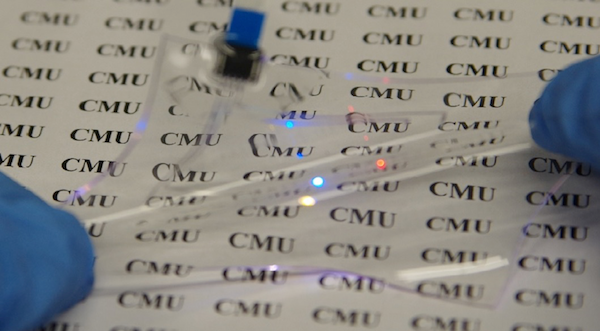Invisible, stretchable circuits
Now we’ve seen everything
Feb 9, 2018

Source: College of Engineering, Carnegie Mellon University
The displays and touchscreens used in next-generation technologies will require transparent conductors that are soft, elastic, and highly stretchable.
Electrically conductive films that are optically transparent have a central role in a wide range of electronics applications, from touch screens and video displays to photovoltaics. These conductors function as invisible electrodes for circuit wiring, touch sensing, or electrical charge collection and are typically composed of transparent conductive oxides. But, they have a weakness.
Most transparent conductors are mechanically stiff. Stretching the inelastic material causes it to break apart and lose electrical functionality. This inability to support strain greatly limits the role of these existing materials for emerging applications in wearable computing, soft bioelectronics, and biologically-inspired robotics. The displays and touchscreens used in these next-generation technologies will require transparent conductors that are soft, elastic, and highly stretchable.
Associate Professor of Mechanical Engineering Carmel Majidi and his research team have developed conductive thin-films that have the unique combination of properties needed for these next-generation technologies: high electrical conductivity, visual imperceptibility, low mechanical stiffness, and high elasticity.

Source: College of Engineering, Carnegie Mellon University
Circuit wiring is not visible on the left example.
Using a laser-based microfabrication technique, the team achieved these properties by coating the surface of a thin rubber film with a fine grid of metal (a eutectic alloy of gallium and indium, EGaIn) that is liquid at room temperature.
To demonstrate the usefulness of the material, the team created a system that monitors air quality and provides visual feedback on pollutant concentration using an electronic contact lens display. Watch the video.
The findings were published in Advanced Materials in a paper titled “Visually Imperceptible Liquid Metal Circuits for Transparent, Stretchable Electronics with Direct Laser Writing” by Chenfeng Pan, Kitty Kumar, Jianzhao Li, Eric J. Markvicka, Peter R. Herman, Carmel Majidi.
Media contact:
Lisa Kulick
lkulick@andrew.cmu.edu
412-268-5444